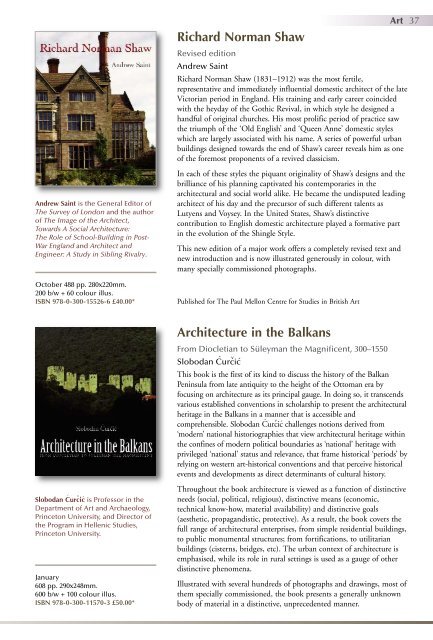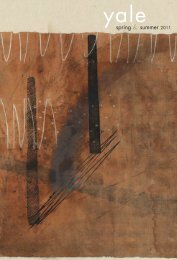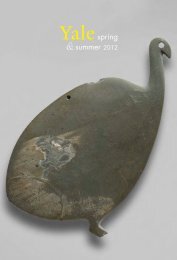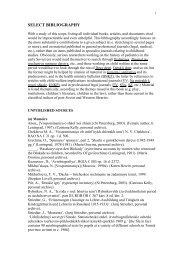Autumn 2009 Catalogue 4 pdfing:1 - Yale University Press
Autumn 2009 Catalogue 4 pdfing:1 - Yale University Press
Autumn 2009 Catalogue 4 pdfing:1 - Yale University Press
Create successful ePaper yourself
Turn your PDF publications into a flip-book with our unique Google optimized e-Paper software.
Andrew Saint is the General Editor ofThe Survey of London and the authorof The Image of the Architect,Towards A Social Architecture:The Role of School-Building in Post-War England and Architect andEngineer: A Study in Sibling Rivalry.October 488 pp. 280x220mm.200 b/w + 60 colour illus.ISBN 978-0-300-15526-6 £40.00*Richard Norman ShawArt 37Revised editionAndrew SaintRichard Norman Shaw (1831–1912) was the most fertile,representative and immediately influential domestic architect of the lateVictorian period in England. His training and early career coincidedwith the heyday of the Gothic Revival, in which style he designed ahandful of original churches. His most prolific period of practice sawthe triumph of the ‘Old English’ and ‘Queen Anne’ domestic styleswhich are largely associated with his name. A series of powerful urbanbuildings designed towards the end of Shaw’s career reveals him as oneof the foremost proponents of a revived classicism.In each of these styles the piquant originality of Shaw’s designs and thebrilliance of his planning captivated his contemporaries in thearchitectural and social world alike. He became the undisputed leadingarchitect of his day and the precursor of such different talents asLutyens and Voysey. In the United States, Shaw’s distinctivecontribution to English domestic architecture played a formative partin the evolution of the Shingle Style.This new edition of a major work offers a completely revised text andnew introduction and is now illustrated generously in colour, withmany specially commissioned photographs.Published for The Paul Mellon Centre for Studies in British Art^Slobodan Curcic ´ ´ is Professor in theDepartment of Art and Archaeology,Princeton <strong>University</strong>, and Director ofthe Program in Hellenic Studies,Princeton <strong>University</strong>.January608 pp. 290x248mm.600 b/w + 100 colour illus.ISBN 978-0-300-11570-3 £50.00*Architecture in the BalkansFrom Diocletian to Süleyman the Magnificent, 300–1550^Slobodan Curcic ´ ´This book is the first of its kind to discuss the history of the BalkanPeninsula from late antiquity to the height of the Ottoman era byfocusing on architecture as its principal gauge. In doing so, it transcendsvarious established conventions in scholarship to present the architecturalheritage in the Balkans in a manner that^is accessible andcomprehensible. Slobodan Curcic ´ ´ challenges notions derived from‘modern’ national historiographies that view architectural heritage withinthe confines of modern political boundaries as ‘national’ heritage withprivileged ‘national’ status and relevance, that frame historical ‘periods’ byrelying on western art-historical conventions and that perceive historicalevents and developments as direct determinants of cultural history.Throughout the book architecture is viewed as a function of distinctiveneeds (social, political, religious), distinctive means (economic,technical know-how, material availability) and distinctive goals(aesthetic, propagandistic, protective). As a result, the book covers thefull range of architectural enterprises, from simple residential buildings,to public monumental structures; from fortifications, to utilitarianbuildings (cisterns, bridges, etc). The urban context of architecture isemphasised, while its role in rural settings is used as a gauge of otherdistinctive phenomena.Illustrated with several hundreds of photographs and drawings, most ofthem specially commissioned, the book presents a generally unknownbody of material in a distinctive, unprecedented manner.












